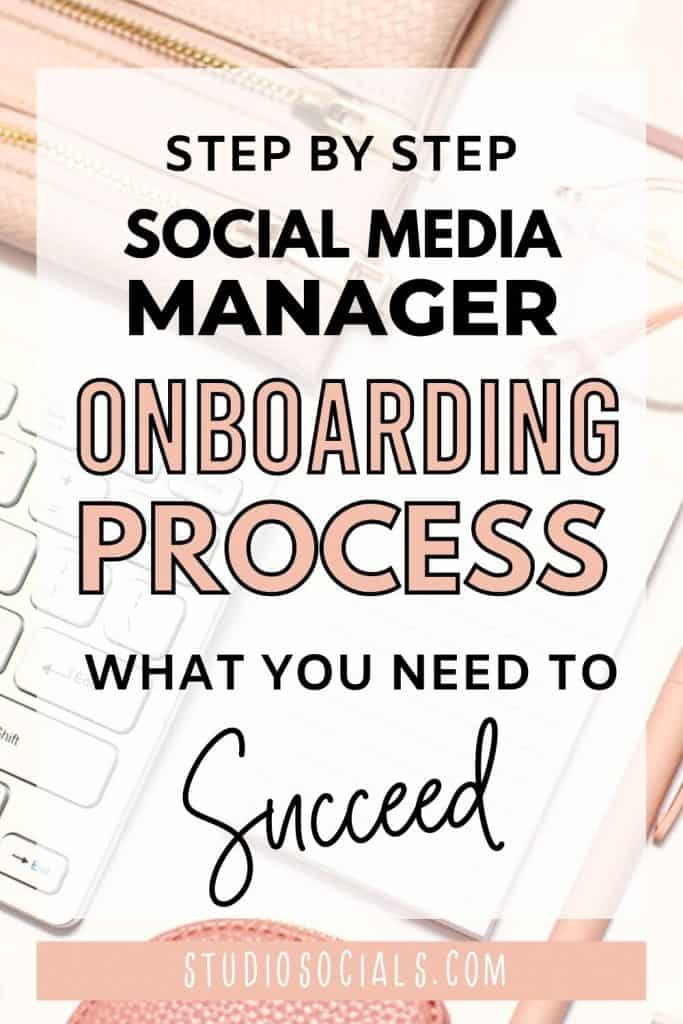Social Media Manager Onboarding Process – What You Need to Succeed
Are you looking for a social media manager onboarding process checklist? If so, you’ve come to the right place! In this article, we’ll discuss why an onboarding process is important and share some tools that will help simplify the process.
As a social media manager, the onboarding process can be a bit daunting. You might be thinking, “Where do I start? What do I need to know?”
Don’t worry, we’re here to help!
The good news is, that there are some great tools out there that can help simplify the process and make sure you have everything you need to succeed.
Keep reading for more information!
Pssst… Looking for social media onboarding templates?
>> Check out our social media manager template shop!<<

Disclosure; This post probably contains affiliate links. We only recommend products we use and love and all opinions expressed here are our own.
What is a Social Media Manager Onboarding Process?
A social media manager onboarding process is a series of steps or tasks that a social media manager takes to get started with a new client.
The goal of an onboarding process is to help the social media manager understand the client’s business, goals, and expectations for their social media accounts.
Onboarding is when you should respond to questions and concerns and ensure your client understands the services available. It might also be the most time-consuming portion of the connection since you’re just getting to know your new customer.
An onboarding process can also help the social media manager set up systems and processes for managing the account effectively.
How much time do you spend with a client in the first month, going back and forth to collect information? I’m sure at some time you’ve dealt with a disorganized client who forgot things and kept coming back to you for more information.
If you don’t have a clear plan for client onboarding, there may be a lot of flaws in the process that will annoy your new client (and you) before you even begin, and also you’re going to waste a lot of time if you don’t have a good procedure in place.
Want to learn more about how you can grow and scale your business as a social media manager? Join our free masterclass: 3 Secrets to Start and Scale a Wildly Successful Social Media Management Business.

Why is a Social Media Manager Onboarding Process Important?
There are many benefits to having an onboarding process for new social media managers, including:
- Helps ensure that the social media manager has all of the information they need to be successful.
- Helps the social media manager understand the client’s business and goals.
- Helps establish systems and processes for managing the account effectively from the start.
An onboarding process is important because it sets the new social media manager up for success with their new client.
Related: How to Get Clients as a Social Media Manager – Tips and Strategy
Related: How to Become a Freelance Social Media Manager
What are the Steps Involved in the Process
There are many different steps that can be involved in a social media manager onboarding process, but some common ones include:
- Reviewing the client’s social media accounts
- Meeting/Kick-off call with the client to discuss their business, goals, and expectations
- Creating a content calendar
- Setting up systems and processes for managing the account
- Training the client on how to use social media
These are just a few of the steps that can be involved in an onboarding process – every situation is unique, so make sure to tailor the process to fit your needs.
Information You Need to Collect
Brand Info and Assets
The first stage of information sharing is to gather brand information and assets. The information is simple and straightforward to complete for your clients
- First and last name
- Address information, including billing and mailing details
- Phone numbers
- Website link
- Logo in all versions and file formats
- Brand colors and hex codes
- Brand fonts and font files
- Social media post templates (for graphics, stories, quotes, etc.)
Access to Their Social Media Accounts
Security is critical in the second stage of onboarding. You’ll need a secure method for keeping and using this data. When it comes to account access, follow industry best practices.
The following is a list of the items you’ll need from the client:
- URLs for all social media profiles (Facebook profile, Facebook page, Instagram,, Pinterest, Twitter, etc.)
- Logins and passwords for those accounts.
- Admin access where applicable (Facebook Business Manager, Google Analytics, etc.)
- What other admins or marketing partners you should be aware of.
Other Important Questions to Ask
In the third phase of onboarding, things get a bit more detailed. Everything from the customer journey to online business interactions will be influenced by what you discover here.
Here are some questions to ask your client in order to obtain the information you need:
- What sort of business will we be handling social media for?
- When did you launch your business?
- What services, information products, books, in-person events, and so on might your company provide? Consider all of the things you do to generate money.
- Who do you want to be your ideal clients?
- What is it about your profession that you enjoy? Clients, money, relationships?
- What percent of your time do you spend in each area?
- Where are you in your company? What have you tried previously? What has been effective for you? What hasn’t worked?
- What kind of connection do you have with your audience? Do they regard you as a colleague or a teacher? Is the tone of your writing more relatable, motivational, or educational? This helps to establish the tone for your writing goals.
- What personal information do you want your audience to know about you (pets, children, hobbies, etc.)?
- Are there any areas on which you’d want me to focus my attention?
- What is the most common action you want visitors to take after reading your post?
- What topics are absolutely off-limits to write about?
- Is there anything else I should be aware of?
Set up a data-driven marketing plan to keep track of all the things that are important in your client’s business.
Follow up monthly to ensure you have current information on what’s going on in your client’s company. And make sure you set clear expectations from the start.

How Can You Simplify the Social Media Manager Onboarding Process
There are a few different ways that you can simplify the social media manager onboarding process, including:
1. Automate Where Possible
Using a client management software like Dubsado to automate the onboarding process can be a great way to simplify things. It can, for example, automatically send the onboarding documents to your client in a special order and generate invoices on a monthly basis by using automation.
An onboarding process that is automated can look something like this:
- You add your new customer to your onboarding process, which sends questionnaire 1 to them.
- After the customer completes questionnaire 1, they receive a brief email of appreciation and request their participation in the next stage of the procedure: questionnaire number 2.
- When the client finishes questionnaire 2, the final questionnaire is sent.
- When the client has completed questionnaire 3, they receive a thank-you email.
When you add the client to the workflow, it all happens automatically, with no further action required of you.
2. Use Social Media Manager Onboarding Templates
Using a social media manager onboarding template can help to standardize things and make it simpler for both you and your client.
3. Create Onboarding Checklists
By using checklists, you can save yourself time and energy when onboarding new clients.
4. Keep it Short and Sweet
Don’t try to jam too much into the onboarding process – keep it short and sweet, and to the point.
5. Make it Easy for Your Client
Your goal should be to make things as easy as possible for your client, so they can get up and running quickly and easily.
By following these tips, you can simplify the social media manager onboarding process and make it easier for both you and your client.
Social Media Manager Onboarding Template Toolkit
There are a few different templates that you can use to help simplify the social media manager onboarding process, including:
1. Social Media Manager Proposal Template
A social media proposal template documents some of your ideas for how you can help the potential customer with their social media profiles. It’s usually being delivered to the client after an initial meeting or phone call, and it’s a great way to get the conversation started about working together.
When you email this form to the client, they’ll be able to see whether your pricing and ideas are suitable for them.
2. Client Welcome Kit Template
I always send my clients a welcome kit with my contact information and other important details that they’ll need to know about working with me.
This is a great way to make sure that your clients have all of the information they need from the start, and it also helps to set expectations for what working together will be like. Don’t forget to be clear about your boundaries from the start!
3. Client Questionnaire Template
To learn more about your client’s organization, objectives, target market, competitors, and prior social media efforts, make a consistent list of questions to ask. These are the questions that will serve as a foundation for developing your social media strategy plan.
4. Social Media Audit Template
A social media audit template works as an inventory of your client’s social media accounts, what works well, and what could be enhanced.
This is a valuable baseline to refer back to as you measure the success of your social media campaigns.
5. Social Media Manager Contract Template
A contract is a must-have for any business relationship, and social media management is no exception.
This template outlines the scope of work, deliverables, payment terms, and other important details about working together.
Make sure you go over the contract with your client before starting work to make sure they understand everything.
6. Social Media Strategy Plan Template
The most essential document after a client contract is a social media strategy plan. A social media strategy outlines the work you intend to accomplish for your client and it’s based on the questions from the client onboarding questionnaire and the outcome of the social media audit.
A social media strategy template should include:
- your client’s social media vision statement and goals
- target audience avatar
- branding (colors, fonts, brand voice etc.)
- competitor analysis
- content strategy (content pillars, content categories, content plan, engagement plan etc)
- what social media tools you are going to use
You’re probably feeling overwhelmed right now. But by using these templates, you can simplify the social media manager onboarding process and make it easier for both you and your client.
Fortunately, we’ve put all of this information into our Social Media Manager Starter Kit. This kit includes all social media client onboarding templates you need.
You can get your hands on the Social Media Manager Starter Kit here.
It’s the perfect toolkit for any social media manager and has a complete set of templates for starting up your freelance career and impressing your new clients with a streamlined onboarding procedure, as well as contract, templates, and checklists.
This kit includes the exact templates I use to sign up new clients and get them smoothly and professionally onboarded without having to send tons of emails back and forth and without forgetting anything important.
Related: 13 Services to Offer as a Social Media Manager
Related: The Ultimate Social Media Manager Checklist: Your Daily To-Do List
Conclusion
Simplifying and automating the onboarding procedure with your existing clients will not only free up your time, but it will also make a positive first impression.
By using the social media manager onboarding process checklist and templates in this article, you can be sure that you have everything you need to get started and succeed.
What other questions do you have about the social media manager onboarding process? Let me know in the comments below!

Pin this post for later!






